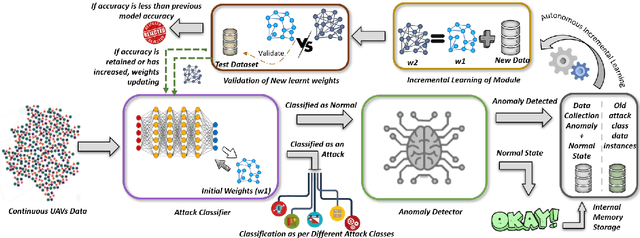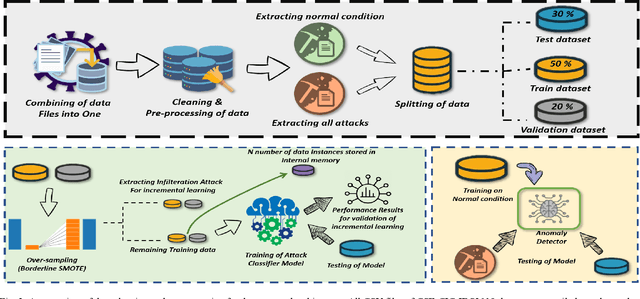Yasir Ali Farrukh
XG-NID: Dual-Modality Network Intrusion Detection using a Heterogeneous Graph Neural Network and Large Language Model
Aug 27, 2024Abstract:In the rapidly evolving field of cybersecurity, the integration of flow-level and packet-level information for real-time intrusion detection remains a largely untapped area of research. This paper introduces "XG-NID," a novel framework that, to the best of our knowledge, is the first to fuse flow-level and packet-level data within a heterogeneous graph structure, offering a comprehensive analysis of network traffic. Leveraging a heterogeneous graph neural network (GNN) with graph-level classification, XG-NID uniquely enables real-time inference while effectively capturing the intricate relationships between flow and packet payload data. Unlike traditional GNN-based methodologies that predominantly analyze historical data, XG-NID is designed to accommodate the heterogeneous nature of network traffic, providing a robust and real-time defense mechanism. Our framework extends beyond mere classification; it integrates Large Language Models (LLMs) to generate detailed, human-readable explanations and suggest potential remedial actions, ensuring that the insights produced are both actionable and comprehensible. Additionally, we introduce a new set of flow features based on temporal information, further enhancing the contextual and explainable inferences provided by our model. To facilitate practical application and accessibility, we developed "GNN4ID," an open-source tool that enables the extraction and transformation of raw network traffic into the proposed heterogeneous graph structure, seamlessly integrating flow and packet-level data. Our comprehensive quantitative comparative analysis demonstrates that XG-NID achieves an F1 score of 97\% in multi-class classification, outperforming existing baseline and state-of-the-art methods. This sets a new standard in Network Intrusion Detection Systems by combining innovative data fusion with enhanced interpretability and real-time capabilities.
ByteStack-ID: Integrated Stacked Model Leveraging Payload Byte Frequency for Grayscale Image-based Network Intrusion Detection
Oct 06, 2023Abstract:In the ever-evolving realm of network security, the swift and accurate identification of diverse attack classes within network traffic is of paramount importance. This paper introduces "ByteStack-ID," a pioneering approach tailored for packet-level intrusion detection. At its core, ByteStack-ID leverages grayscale images generated from the frequency distributions of payload data, a groundbreaking technique that greatly enhances the model's ability to discern intricate data patterns. Notably, our approach is exclusively grounded in packet-level information, a departure from conventional Network Intrusion Detection Systems (NIDS) that predominantly rely on flow-based data. While building upon the fundamental concept of stacking methodology, ByteStack-ID diverges from traditional stacking approaches. It seamlessly integrates additional meta learner layers into the concatenated base learners, creating a highly optimized, unified model. Empirical results unequivocally confirm the outstanding effectiveness of the ByteStack-ID framework, consistently outperforming baseline models and state-of-the-art approaches across pivotal performance metrics, including precision, recall, and F1-score. Impressively, our proposed approach achieves an exceptional 81\% macro F1-score in multiclass classification tasks. In a landscape marked by the continuous evolution of network threats, ByteStack-ID emerges as a robust and versatile security solution, relying solely on packet-level information extracted from network traffic data.
Detecting Unknown Attacks in IoT Environments: An Open Set Classifier for Enhanced Network Intrusion Detection
Sep 28, 2023Abstract:The widespread integration of Internet of Things (IoT) devices across all facets of life has ushered in an era of interconnectedness, creating new avenues for cybersecurity challenges and underscoring the need for robust intrusion detection systems. However, traditional security systems are designed with a closed-world perspective and often face challenges in dealing with the ever-evolving threat landscape, where new and unfamiliar attacks are constantly emerging. In this paper, we introduce a framework aimed at mitigating the open set recognition (OSR) problem in the realm of Network Intrusion Detection Systems (NIDS) tailored for IoT environments. Our framework capitalizes on image-based representations of packet-level data, extracting spatial and temporal patterns from network traffic. Additionally, we integrate stacking and sub-clustering techniques, enabling the identification of unknown attacks by effectively modeling the complex and diverse nature of benign behavior. The empirical results prominently underscore the framework's efficacy, boasting an impressive 88\% detection rate for previously unseen attacks when compared against existing approaches and recent advancements. Future work will perform extensive experimentation across various openness levels and attack scenarios, further strengthening the adaptability and performance of our proposed solution in safeguarding IoT environments.
An Autonomous Self-Incremental Learning Approach for Detection of Cyber Attacks on Unmanned Aerial Vehicles (UAVs)
Dec 18, 2021



Abstract:As the technological advancement and capabilities of automated systems have increased drastically, the usage of unmanned aerial vehicles for performing human-dependent tasks without human indulgence has also spiked. Since unmanned aerial vehicles are heavily dependent on Information and Communication Technology, they are highly prone to cyber-attacks. With time more advanced and new attacks are being developed and employed. However, the current Intrusion detection system lacks detection and classification of new and unknown attacks. Therefore, for having an autonomous and reliable operation of unmanned aerial vehicles, more robust and automated cyber detection and protection schemes are needed. To address this, we have proposed an autonomous self-incremental learning architecture, capable of detecting known and unknown cyber-attacks on its own without any human interference. In our approach, we have combined signature-based detection along with anomaly detection in such a way that the signature-based detector autonomously updates its attack classes with the help of an anomaly detector. To achieve this, we have implemented an incremental learning approach, updating our model to incorporate new classes without forgetting the old ones. To validate the applicability and effectiveness of our proposed architecture, we have implemented it in a trial scenario and then compared it with the traditional offline learning approach. Moreover, our anomaly-based detector has achieved a 100% detection rate for attacks.
 Add to Chrome
Add to Chrome Add to Firefox
Add to Firefox Add to Edge
Add to Edge